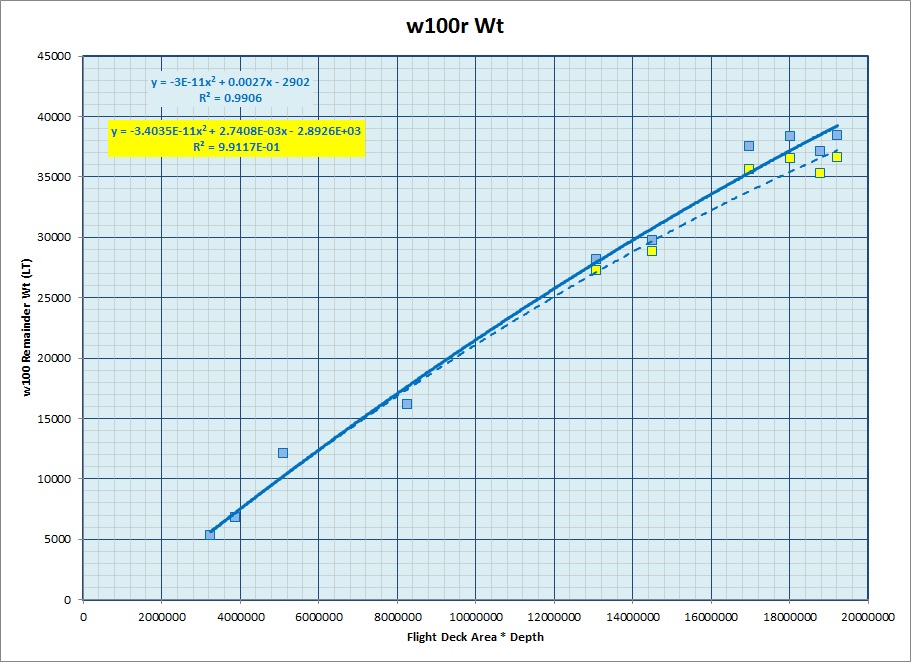
Aircraft Carrier w100 (Structural) Weight Estimating
For estimating a
design's SWBS Group 100 Structural weight I have taken the weight data
provided in Ref CV1 and modified it into to groups as defined below;
w100r = which represents the base (or remaining) SWBS Group 100 weight of a ship after the weight impacts of a ship's Elevator/Lifts (a portion of SWBS 588), Catapults (SWBS 587) , and Arrestor Gear (SWBS 586) plus the portion of the Operating Fluids (SWBS 598) and Spare Parts and Spacial Tools (SWBS 599) associated with the SWBS 586, 587 and 588 weights for that design.
w100+ = the portion of SWBS 100 weight due to the the installation of Catapults, Arrestor Gear, and Lifts/Elevators (which gets 'added to' the w100r to give the total w100 ship weight.
The figure below shows both the Total w100 weight and the w100r weight for the vessels that I have weight information for. The Blue data points represent the total w100 weights while the Yellow data points represent the w100r data. As can be seen in the graph, for the vessels on the right side of the plot, which represent the larger CATOBAR carriers and designs developed by the USN the difference between w100 and w100r is more appreciable than for the ships on the left side of the plot which represent two large deck amphibious vessels and two STOVL carrier designs that were developed for the USN (including the Sea Control Ship which was the basis design for the Spanish Principe d' Asturias STOVL carrier).
In this figure I have plotted the w100 & w100r weigth data against the ship's Flight Deck Area * Depth, as this appeared to provide a good fit for both the CATOBAR and STOVL type designs.

w100r = which represents the base (or remaining) SWBS Group 100 weight of a ship after the weight impacts of a ship's Elevator/Lifts (a portion of SWBS 588), Catapults (SWBS 587) , and Arrestor Gear (SWBS 586) plus the portion of the Operating Fluids (SWBS 598) and Spare Parts and Spacial Tools (SWBS 599) associated with the SWBS 586, 587 and 588 weights for that design.
w100+ = the portion of SWBS 100 weight due to the the installation of Catapults, Arrestor Gear, and Lifts/Elevators (which gets 'added to' the w100r to give the total w100 ship weight.
The figure below shows both the Total w100 weight and the w100r weight for the vessels that I have weight information for. The Blue data points represent the total w100 weights while the Yellow data points represent the w100r data. As can be seen in the graph, for the vessels on the right side of the plot, which represent the larger CATOBAR carriers and designs developed by the USN the difference between w100 and w100r is more appreciable than for the ships on the left side of the plot which represent two large deck amphibious vessels and two STOVL carrier designs that were developed for the USN (including the Sea Control Ship which was the basis design for the Spanish Principe d' Asturias STOVL carrier).
In this figure I have plotted the w100 & w100r weigth data against the ship's Flight Deck Area * Depth, as this appeared to provide a good fit for both the CATOBAR and STOVL type designs.

For a new design, Group w100+ data can be determined from the data listed on the Aircraft Lifts/Elevators, Catapults & Ski Ramps, and Arrestor Gear webpages.
This document maintained by PFJN@mnvdet.com.